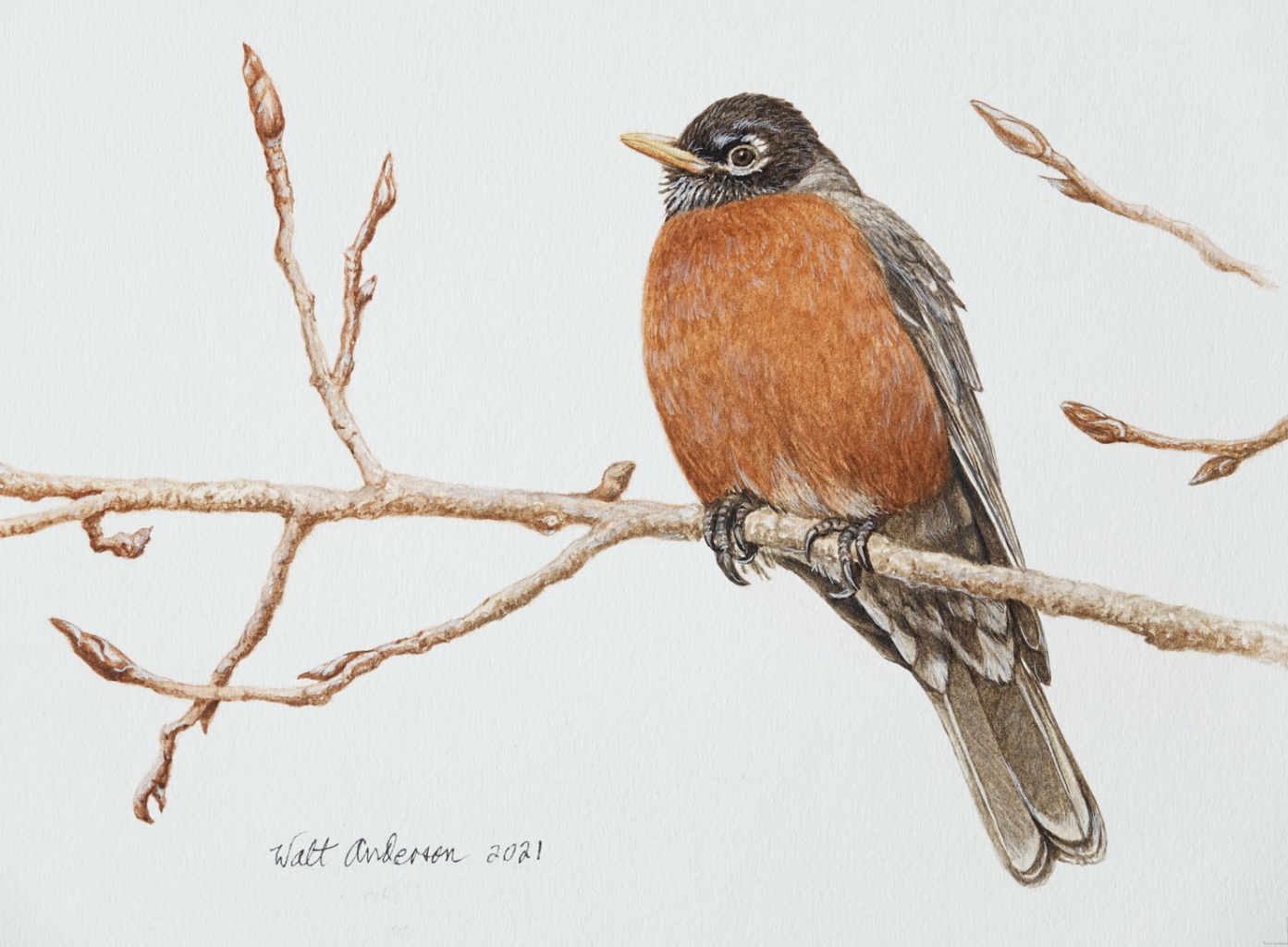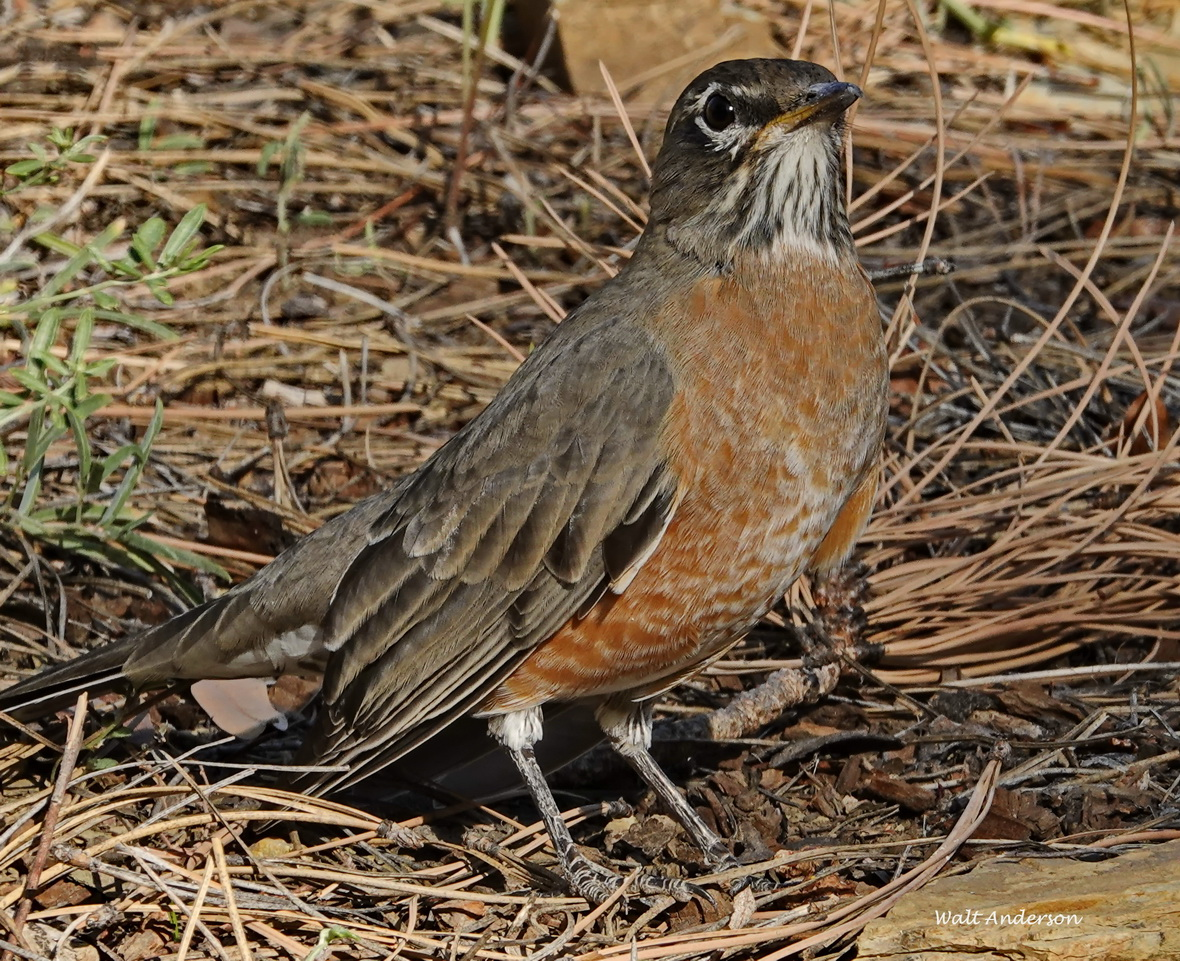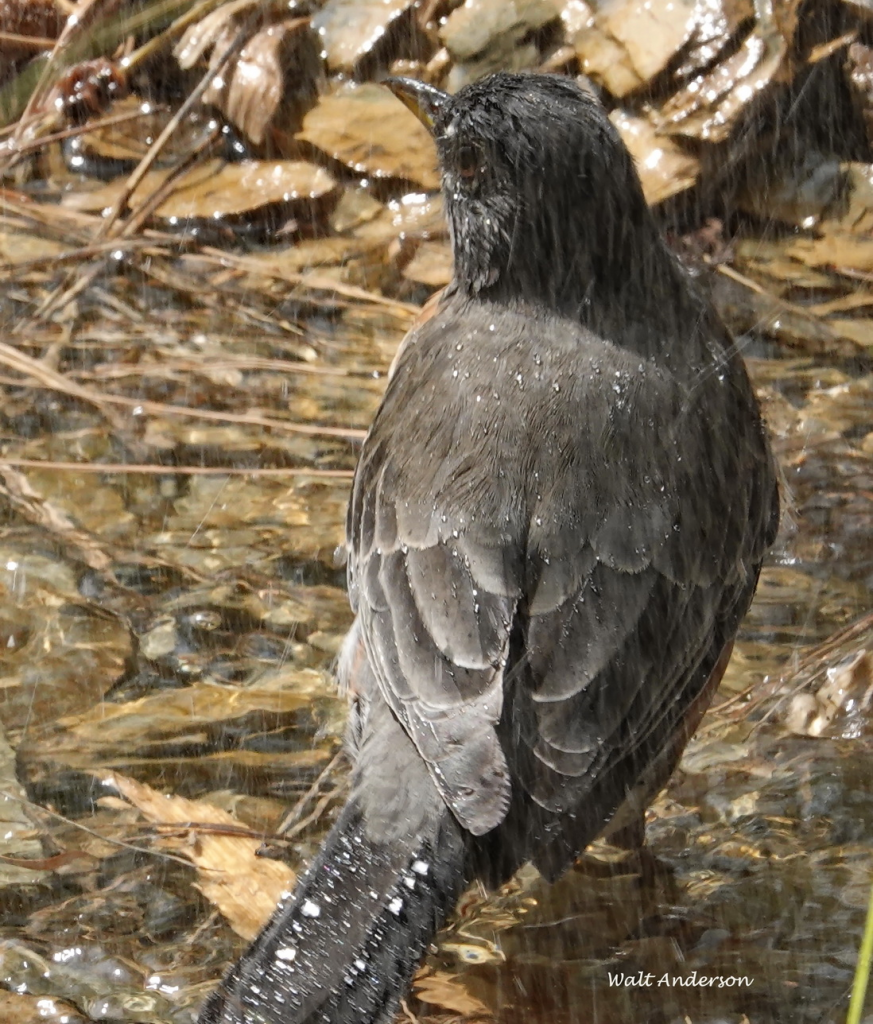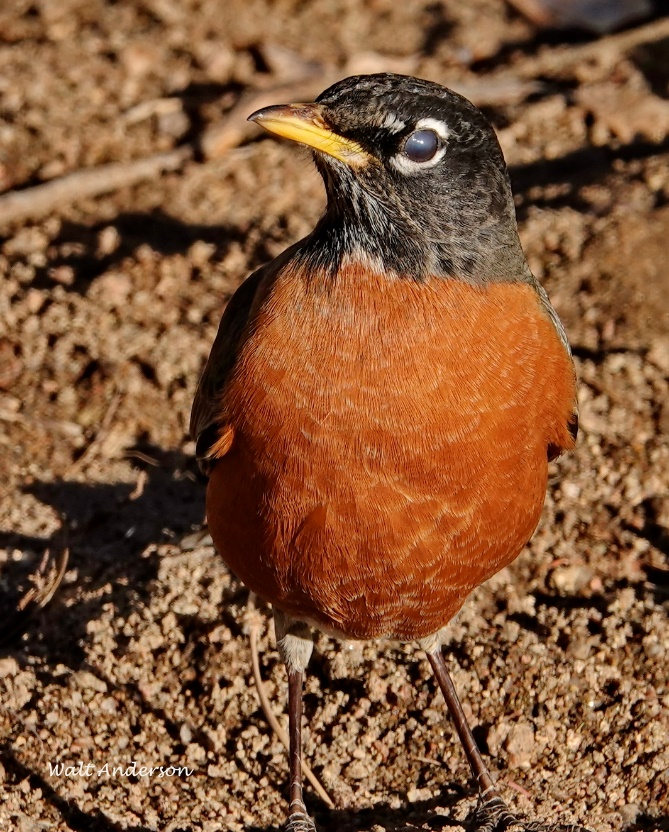
American Robin
by Walt Anderson
On February 2, a chunky rodent named Punxsutawney Phil popped out of his burrow near Gobbler’s Knob in Pennsylvania and cast a vivid shadow, thus “predicting” 6 more weeks of winter. Sure enough, within the next week, a massive blizzard hit the East, and the groundhog’s augury was borne out bigtime. Never mind that he’s been wrong more times than right and that it is hardly credible that a marmot (which is what he is) could still be alive and active for 135 years!
We in Arizona, lacking such an unpronounceable mammalian icon, look for other signs of spring. This frosty morning along Granite Creek in the Granite Dells, the melodic chirruping of a robin seemed a far more fitting harbinger of the change of seasons. It lifted my spirits, reminding me that soon buds will be expanding on the trees, the wintering waterfowl will grow restless and head north, and dozens of other bird species will join the dawn chorus. So today I want to honor this handsome thrush, “America’s favorite songbird,” a familiar and charming bird that doesn’t need any shadowy quackery to win our hearts—the American Robin.

Robins are the most widespread of all the American thrushes, breeding throughout nearly all of North America and wintering in most of the continental United States and Mexico. The migratory birds often show up in snowy climes in late winter and initiate singing, which is why they are considered the avian harbinger of spring. They can occur in large wintering flocks and often gather nightly in huge roosts.

The American Robin is a distinctive bird, with its brick-red breast, slaty head and back, white eye marks, and bright yellow bill. As songbirds go, it is fairly large and spends a lot of time on the ground, running and hopping as it seeks invertebrate prey or gathering in fruit trees to gobble down colorful, fleshy fruits. Though it occurs in many native habitats, it is also common in suburbia, which is why it is so well known.

Males tend to be slightly larger than females and to have richer coloration: a darker head and brighter breast. The scientific name is Turdus migratorius. There are about 174 species in the family Turdidae, which is one of the most cosmopolitan families of songbirds in the world, found on every continent except Antarctica. The genus Turdus has about 87 species. Ironically, the common name “robin” was given because of its superficial resemblance to the European Robin, which belongs to an entirely different family!

If we were just a bit more accurate in our categories, we would understand that our “robin” is basically a large thrush, related to other thrushes such as the Hermit, Swainson’s, Gray-cheeked, and Wood Thrush, as well as the Veery. The family also includes the bluebirds (a North American branch of the family), the Townsend’s Solitaire, and a number of Neotropical birds variously called robins, thrushes, or nightingalethrushes. Are we confused already? The problem is that early describers were hung up on appearances, and we ought to know that appearances are deceiving. That has become abundantly clear now that we have sophisticated DNA analyses done by gene-iuses.
Do you remember that witty poem that includes “four-and-twenty blackbirds baked in a pie”? Well, those were not Red-winged or Brewer’s Blackbirds; they were European Blackbirds, Turdus merula. They look just like our American Robin in build and attitude, but they are black! So who is that British robin for which our birds were mistakenly named?

The REAL robin, if you want to go by nomenclatural priority, is Erithacus rubecula. I don’t happen to have a photo of one, but it is similar in build and somewhat in coloration to its African relative shown here, the Cape Robin-Chat. These belong to the enormous family, Muscicapidae, which has about 327 species. That family is commonly called the Old World Flycatchers. To confuse the layperson even more, the Old World Flycatchers are not related to our New World Flycatchers like the kingbirds, peewees, phoebes, and little brown jobs in the genus Empidonax. Many of the birds in that family go by some variation of “flycatcher,” but other groups include robin-chats, scrub-robins, magpie-robins, palm thrushes, forktails, stonechats, wheatears, whistling thrushes, and shortwings. Some are even “redstarts,” and we blew it again with the name American Redstart, which is really a wood warbler!
To complicate things even more, there are 49 species of “Australasian Robins,” family Petroicidae, and they are not related to “robins” in either of the other two large families!
The problem is with “common names.” Sometimes the same name has been applied to similar species with nothing else in common. To their credit, taxonomists have worked out most evolutionary relationships, and the taxonomic categories (order, family, and genus) make sense when looked at that way. However, the general public has not been convinced to see things that way, since long-term general usage is hard to overturn. Ironically, we often use scientific names for plants without blinking an eye—azalea, rhododendron, narcissus, iris, amaryllis, philodendron, chrysanthemum, euphorbia, and many more. Can we learn to be more accurate with animal names?

I grew up in the Pacific Northwest north of Seattle, and when heavy snows would occasionally come, a fascinating bird would appear to feed on apples and pears that remained on our winter trees. We called these shy birds Alaska Robins, as they appeared to have arrived from the north and did resemble robins, albeit a bit fancier. We know them now as Varied Thrushes, other members of the family Turdidae.
I think we need to hold an international summit and work out some treaties on what we call birds. Let’s agree that all members of the Turdidae should be called “thrushes” (so much better than “turdids”). Let’s keep all the real robins, robin-chats, and the like in the Muscicapidae and give the Australasian robins something catchy, like petroicids (OK, I am going to take flack for that, so you come up with a better name!). Robinettes?

So now let’s return to our misnamed American Robin. In fall and winter, these birds consume a lot of fruit, and they are excellent seed dispersers. Larger seeds are regurgitated, but smaller seeds pass through the digestive tract and get scattered all over. Those that land on my car windshield likely won’t germinate. The birds are selective feeders, choosing larger fruits when given a choice. They have high digestive efficiency for glucose but can’t digest sucrose, and they choose fruits accordingly. Prior to migration, they may choose fruits with higher lipid (fat) content. When juniper berry crops are good, robins may gather by the hundreds, competing with bluebirds, solitaires, and Hermit Thrushes. I always wish for a berry Christmas.

During the summer, especially when feeding young, robins seek out invertebrates like grubs (beetle larvae) and, of course, earthworms. They stalk carefully over the ground, often tilting the head to detect burrowing inverts. It looks like they are listening, but since they are a prey species with eyes on the sides of the head to better watch out for danger, they can focus better by training one eye on the ground at a time. They also use the bill to rake material away from the ground surface, as this one has done to get through piles of cottonwood fuzz. And it worked—it has a worm; this could be the early bird.
Perhaps some of you will remember Martin Luther’s actions in 1521 at the Diet of Worms. No, it’s not the same; it must be convergence.

Robins also need water. Like most songbirds, they sip and then tip back their heads to swallow. They also need mud to construct their nests, so availability of free water may limit their nesting habitat, especially in the often-dry pine forests of the Southwest.

They also relish a good shower and do some pretty fancy flash-dance moves while bathing. Then they often move to a warm spot to sunbathe; I just love baskin’ robins.

Successful birds must plenty of attention to physical maintenance. One structure that helps protect and moisten the eye is the nictitating membrane, also called third eyelid. Here it covers the eye but still enables vision, as it is transparent.

Also, at the gape (the junction of upper and lower mandibles at the base of the mouth) are rictal bristles, which are hypothesized to protect the eye from loose particles (e.g., soil, leaves, insect fragments). People unfamiliar with “rictal” sometimes replace the “i” with an “e.” That shows complete lack of vowel control.

American Robins build substantial nests of grasses, twigs, needles, and like, with the cup cemented with mud. Then a soft inner lining is emplaced to cushion the robin’s-egg blue eggs. We think of them as “sky blue,” but color experts say that they vary from paler “deep bluish glaucous” to darker “Nile blue.” I knew about the Blue Nile, but as for that color, I must have been in denial.
The female is the nest architect and contractor, but the male helps bring provisions during the 13 days that the chicks are in the nest and during the three-week post-fledging period. The female may start a second nest during that time.

Young thrushes, including bluebirds and solitaires, are spotted, and so is the baby robin. Supposedly this gives them some camouflage, but in my experience, the fledglings are plenty conspicuous and quite easy to spot. Robins, especially young ones, are highly vulnerable to Sharp-shinned and Cooper’s Hawks and to small mammalian predators, especially cats (whether well-fed pets or feral). Once a cat’s bite has penetrated skin, infection is highly likely, and even antibiotic injection is rarely effective at saving the bird. This kind of mortality is on us; cats do what cats do, so it is our responsibility to keep them from hunting birds. Mortality by cats is added to by collisions with windows and buildings, poisoning by pesticides, loss of habitat, and more. Even in the best of circumstances, there is just about 100% turnover in a robin population within six years. Compare that to Punxsutawney Phil, reputed to have popped up every spring for the past 135 years! Some myths are hits.

Here is my recent 8×10” watercolor tribute to this fine bird. I wish I had the means to paint its lovely song! It may seem early, but spring is on the way, and the robin knows it. May YOUR spring be filled with robins!
